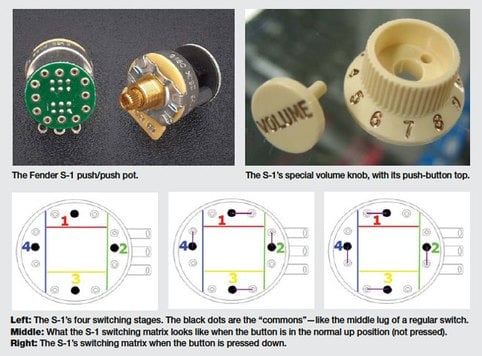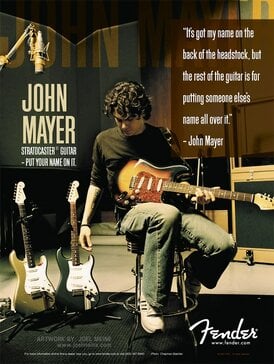|
In 2000 Stratocaster was still the benchmark not only for the guitarists who had already been using it since the previous decade, but also for the emerging ones, thus becoming the junction point between the old and the new generation of musicians. The '90s had been very chaotic years: lots of model were put on the market, removed shortly after and replaced by new ones. It was hard, if not impossible, to keep up with all the variations on Fender catalogs and remember the differences between the many Stratocasters. In the new millennium things did not change significantly. At the beginning of 2000 the factory guitars, Squier and made in Japan excluded, were divided into nine series: American Standard, Hot Rodded American Standard, American Special (including Jimi Hendrix Voodoo and some Floyd Rose models), American Deluxe, American Vintage, Artist (the new Signature’s denomination which now included some made in Mexico guitars), and the Mexican Classic, Standard and Deluxe. In addition, there were the Custom Shop series which included, besides the limited editions and the tributes, Time Machine, Custom Artist and Custom Classic.
|
So the models were quite a lot and increased even more because the “variants” with the hard tail bridge, or the left hand models, which began to be considered as separate guitars.
The most important innovation of the summer of 2000 was the (temporary) replacement, after 13 years, of the American Standard Series with the American Series.
|
In mid-2003 switch S-1 was introduced in some American Series and in 2004 also in the new American Deluxe Series; it was an “invisible” push pull switch placed on the volume knob that didn’t alter the guitar’s physiognomy. This switch could perform different functions, as splitting humbuckers in single coils, permitting new pickup combinations (for example, bridge and neck positions together or even all three single coils simultaneously), or switching the pickups from series to parallel.
|
The old Hot Rodded American Standard Series also was replaced by the American Hot Rodded Series and American Strat Texas Special, American Fat Strat Texas Special and American Double Fat Strat took place of, respectively, Roadhouse, Lone Star and Big Apple. This series lasted only a few years, until 2003, when it was incorporated into the new American Series. Now the ”Hot Rodded” guitars no longer had a specific name: it was sufficient to choose the desired instrument among the various American Series models which also included American Stratocaster HH and American Stratocaster HSS.
 Tech Tonic bridge
Tech Tonic bridge
In 2002 Highway One was born, the cheapest ever Stratocaster completely made in US (excluding the hybrids of the 90s), of which two series were produced. In 2010 the new American Special Stratocaster, which cost just 100 dollars more than the Highway, joined this. Only a few people remember that American Special Series was born as a series which at the beginning included guitars outside the classical schemes, as Stratocaster with Floyd Rose or Strat-O-Sonic, equipped with the Fender Tech-Tonic Stop Tail bridge, or 2001-2002 '68 Reverse Stratocaster Special, which replaced Voodoo Stratocaster in Jimi Hendrix’s tribute guitars.
Even Artist Series were in part modified: in the summer of 2001 Noiseless pickups took the place of Lace Sensor on Clapton and Beck (in the latter the neck was also streamlined considerably), and new guitars joined the series, including Mark Knopfler, Eric Johnson and John Mayer signature Stratocasters. Above all, Custom Shop inaugurated Stratocaster Replicas era. Who wouldn't want to take up the instrument of a Guitar hero? The dream of every guitarist pushed Fender Master Builder to realize limited editions of identical copies of Clapton’s Blackie or Brownie (in 2006 and 2013 respectively), Stevie Ray Vaughan’s Number One (2004), Malmsteen’s Play Loud (2008), just to name a few.
In 2010, Fender Stratocaster, Squier and Custom Shop models excluded, Stratocasters were organized into twelve series (about forty models): the made in US American Deluxe, American Vintage, American Special, American Standard, Artist, Highway One, Vintage Hot Rod, and the Mexican Classic, Classic Player, Deluxe, Road Worn, Standard.
In conclusion, the trend started in the '90s characterized by a rapid expansion of the series number and of the different Stratocasters ramped up in the new millennium. Now there were many models which could be purchased and they were very different, both by type and by economic range. Moreover, the Custom Shop, which was born to produce limited editions only and in the '90s saw the birth of some series, turned itself more and more into a factory in the factory, with many series and many more models.
In conclusion, the trend started in the '90s characterized by a rapid expansion of the series number and of the different Stratocasters ramped up in the new millennium. Now there were many models which could be purchased and they were very different, both by type and by economic range. Moreover, the Custom Shop, which was born to produce limited editions only and in the '90s saw the birth of some series, turned itself more and more into a factory in the factory, with many series and many more models.
AMERICAN VG STRATOCASTER
 American VG Stratocaster knobs
American VG Stratocaster knobs
This guitar deserves special consideration. At the beginning of the new millennium there was a strong tendency to bring the digital into the world of guitars. In 2003 Line 6 presented Variax, a guitar that allowed multiple sounds to be obtained, including many imitations of Fender. It was therefore inevitable that Fender would also enter this new market sector. In that same period, former guitarist Jeff Baxter went to Ikutaro Kakehashi, the head of Roland, a Japanese company at the forefront of digital music, to propose a Fender/Roland modeling guitar, which was actually presented in 2007 and named American VG Stratocaster. This guitar, which remained in the Fender catalog until 2009, could get sounds never achieved before thanks to Roland technology. To be honest already in the '90s some Fender/Roland guitars had appeared: The 1995 American Standard Roland GR-Ready and the 1998 Mexican Standard Roland Ready Stratocaster. But they both needed an external synth. The new American VG Stratocaster, on the othe hand, was equipped with all the necessary electronics. It was sufficient to plug it into a normal amplifier to get, in addition to the classic Stratocaster sound, all the others that the Roland synth could produce. The new sounds were controlled by two extra knobs and by the pickup added to the Roland GK bridge. The Mode Control knob allowed to choose between five types of sound: the letter “N” stood for the normal Stratocaster sound, “S” for modeled Stratocaster, “T” for modeled Telecaster, “H” for modeled Humbucker and “A” for modeled Acoustic. The second extra knob provided a choice between standard tuning and four other, different tunings, plus the simulation of a twelve string guitar.
Antonio Calvosa









